Enough of the “SWAGS” (Scientific Wild Ass Guesses); it’s time for some facts! Join Scott and I while we examine and hopefully discover the intricacies of Seagate’s latest and potentially greatest drive to date: the Barracuda 7200.10, 750 gigabyte hard drive.
INTRODUCTION
Within the last two months we have published two reviews on two separate models of Seagate’s hard drives that were each 500 Gb in capacity: the 7200.9 and the NL-35. With each review we stipulated that capacities of these drives were growing at an incredibly rapid rate to contend with the consumer’s need for more data storage. In the back of our minds, although not publicly stated, we felt that a pinnacle had been reached at the 500 Gb level that would take a while to surpass. Little did we know that just around the corner was an even newer and more expansive technology waiting to meet our storage needs. So much for supposition on our parts!
Common sense would seem to indicate that there has to be a limitation to the number of platters that can be placed in these drives while still maintaining the 3.5 inch form factor that is used in the vast majority of all of today’s desktop computers and servers. Did Seagate sprinkle a magic dust onto the surface of these platters to make them hold more data? While somewhat of a joke this question has some semblance of accuracy that will be discussed later in this review.
What is even more amazing than the seemingly endless increase in capacities is that each new drive iteration to date has been quantitatively faster than its predecessor. How the speed of these drives has continued to proportionately rise while still keeping the same 7200 RPM rating is also somewhat of a mystery. One answer might be that the cache size has continued to grow from 2Mb to 8Mb, and now to 16Mb. Is this the answer? We’ll also discuss this aspect of drive architecture later in this review.
Enough of the “SWAGS” (Scientific Wild Ass Guesses); it’s time for some facts! Join Scott and I while we examine and hopefully discover the intricacies of Seagate’s latest and potentially greatest drive to date: the Barracuda 7200.10, 750 gigabyte hard drive.
FUNCTIONALITY & SPECIFICATIONS
Before looking at the drive specs we thought it appropriate to do some research and answer some of the questions initiated in the Introduction. We learned many of the answers to many of our questions by perusing technical papers supplied by Seagate.
First, and foremost, how did Seagate increase the volume of their drives so radically? To answer that question we must first understand areal density. To paraphrase Webopedia’s definition: Areal Density also called bit density is the amount of data that can be packed onto a storage medium. Areal densities are generally measured in gigabits per square inch. The term is useful for comparing different types of media, such as magnetic disks and optical disks. Current magnetic and optical disks have areal densities of several gigabits per square inch.
Next we turned to Seagate for their technical comments on areal density: “To increase areal densities in longitudinal recording and boost overall storage capacity, the data bits must be shrunk and packed more closely together. However, if the bit becomes too small, the magnetic energy holding the bit in place may also become so small that thermal energy can cause it to demagnetize, a phenomenon known as superparamagnetism. To avoid superparamagnetism, disc media manufacturers have been increasing the coercivity (the field required to write a bit) of the media. However, the fields that can be applied are limited by the magnetic materials making up the write head.”
FUNCTIONALITY & SPECIFICATIONS cont.
It would seem from that technical comment that areal density is approaching a limit in its expandability. We learned by reading further that a new process call “perpendicular recording” had been implemented to help augment the maximization of areal density. What is “perpendicular recording”? Even though we are pseudo geeks we had to rely on Seagate again to clarify that term: “In perpendicular recording, the magnetization of the disc, instead of lying in the disc’s plane as it does in longitudinal recording, stands on end, perpendicular to the plane of the disc. The bits are then represented as regions of upward or downward directed magnetization. (In longitudinal recording, the bit magnetization lies in the plane of the disc and flips between pointing in the same and opposite directions of the head movement.) The media is deposited on a soft magnetic under-layer that functions as part of the write field return path and effectively produces an image of the recording head that doubles the recording field, enabling higher recording density than with longitudinal recording.”
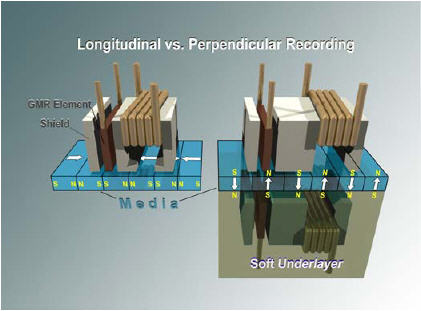
“Seagate has demonstrated a recording areal density with perpendicular recording of 245 Gbpsi (Gigabits per square inch) with a data rate of 480 Mbits per second – more than double the 110 Gbpsi used in today’s highest areal density disc drives – and 500 Gbpsi, which will increase the capacity of today’s drives 5-fold, is possible with the new technology. At 500 Gbpsi, a 3.5-inch disc drive could store two terabytes of information, a 2.5-inch drive in a laptop could hold 500GB and a 1-inch drive, such as those in MP3 players, could store as much as 50GB of data. This explanation, although somewhat simplified, not only answers our questions regarding the radical increase in capacity; but also the noticeable speed increases with each new drive. Ain’t technology just grand?
Specifications
Seagate has added 14 new drives to their 7200.10 product family ranging in size from 200GB to 750GB many available in Ultra ATA 100, SATA 150, and SATA 300. Aside from these build variances their are also 8Mb and 16Mb cache versions on most drives except the 200GB which is limited to 8Mb. For purposes of today’s review we’ll limit our discussion to the the 750GB version(s) of this family.

Features
- Perpendicular Recording increases data density while decreasing moving parts for a more dependable drive.
- Adaptive Fly Height offers consistent read/write performance from the beginning to end of your computing workloads.
- Clean Sweep automatically calibrates your drive each time you power up.
- Directed Offline Scan runs diagnostics when storage access is not required.
- The first 3.5-inch perpendicular recording drive combined with the highest available capacity reduces system repairs and storage upgrades.
- Seagate SoftSonic motor enables whisper-quiet operation.
- Enhanced G-Force Protection defends against handling damage.
- The product carries an unprecedented five-year warranty.
First Impression
When we unpacked this drive from it’s sturdy shipping container our first visual impression was not really any different than the previous two Seagate drives we’ve recently reviewed. Physically it may be slightly heavier, but not by much. The top of the drive is unremarkable other than the obvious changes in serial number, model number, and other data respective to the 7200.10.
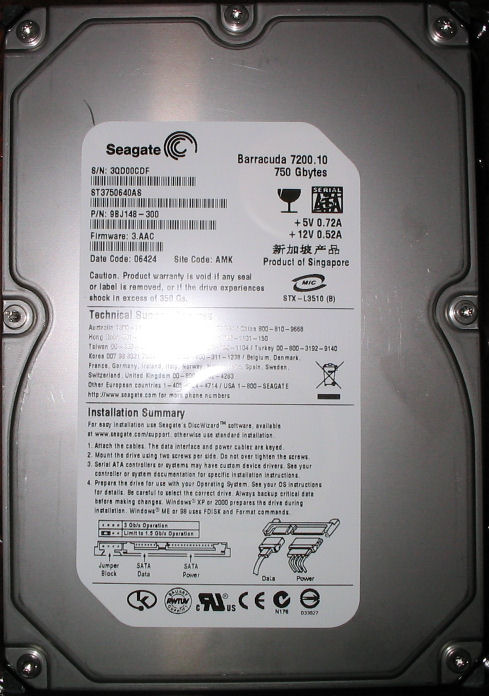
While the bottom of drive appears unremarkable from a gross perspective, to the right of the data and power connectors (hard to visualize in this picture) is a four pin jumper. This jumper will determine whether the drive operates in 150 Mb/sec mode or at the higher 300 MB/sec mode. The two pins are enabled by default, meaning that your Seagate Barracuda 7200.10, 750 GB drive will arrive and operate in the 150 MB/sec mode unless you remove the jumper allowing the drive to operate in 300 Mb/sec mode associated with Serial ATA 2. This change is only advantageous if your motherboard supports the higher data transfer rates.
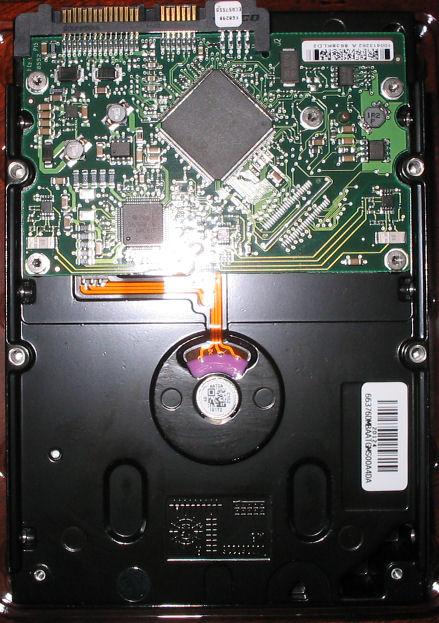
TESTING
Test System
- AMD X2 5000+ Socket AM2
- Foxconn C51XEM2AA nForce 590 Motherboard
- 2GB kit of Corsair TWIN2X2048-6400C4 DDR 2 SDRAM
- 2 x NVIDIA 7800GTX 512MB
- Seagate 7200.10 750GB hard drive
- SB X-FI Platinum
- PC Power and Cooling 1KWatt SLI Power Supply
- Lian-Li V1200 Case
- Windows XP Pro SP2
- Dell 20″ LCD
- ForceWare 81.98 and DirectX 9.0c
Benchmarking Tools:
- SiSoft Sandra 2005
- Futuremark’s PCMark05
- Simpli Software’s HD Tach
Test Methodology
We decided to do a side by side comparison of the 7200.10, 750GB drive to its first cousin the 7200.9, 500GB drive. For the record both drives have a 16 MB cache so the primary differences will be in capacity but more importantly testing the new perpendicular recording technology as opposed to the older more established lateral approach. We ran the basic benchmarks captioned above and made a few wagers prior to seeing their results. In fact we were both winners: Scott wagered that the new perpendicular recording technology couple with the difference in areal density would make the 7200.10 a clear cut winner, I hedged my bet by replying the winner would be a Seagate hard drive with a capacity of 500GB or greater.
Sandra 2005 Benchmarks
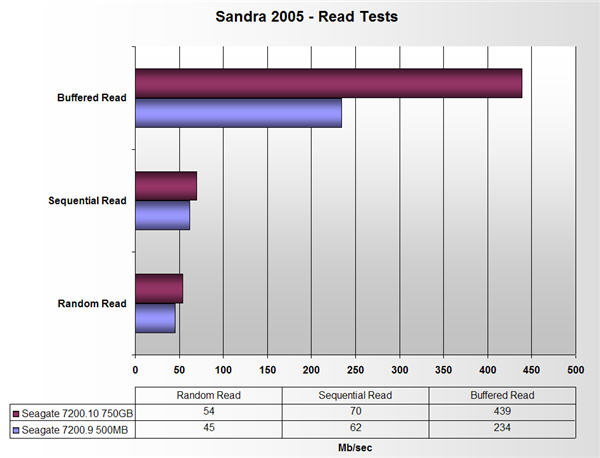
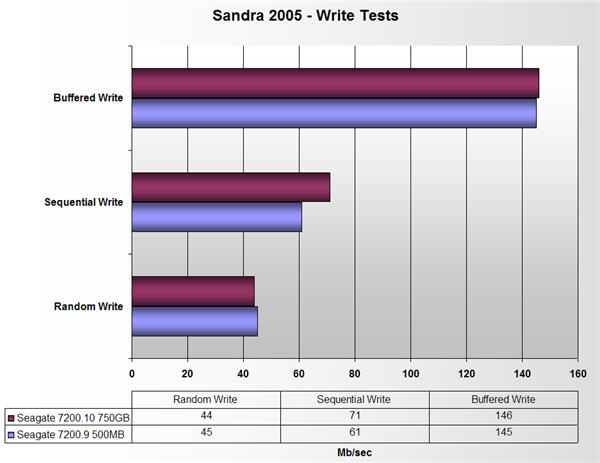
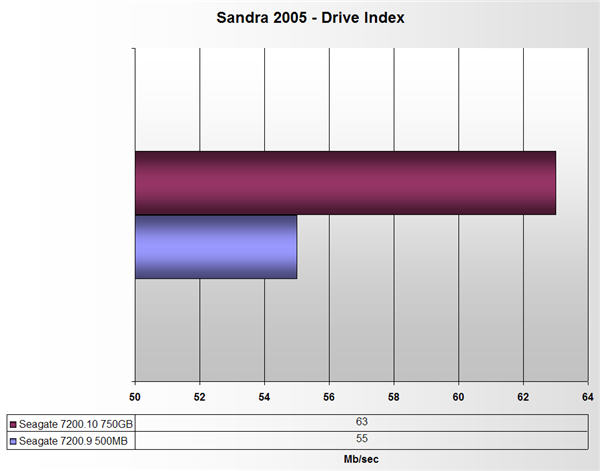
TESTING cont.
HD Tach Benchmark
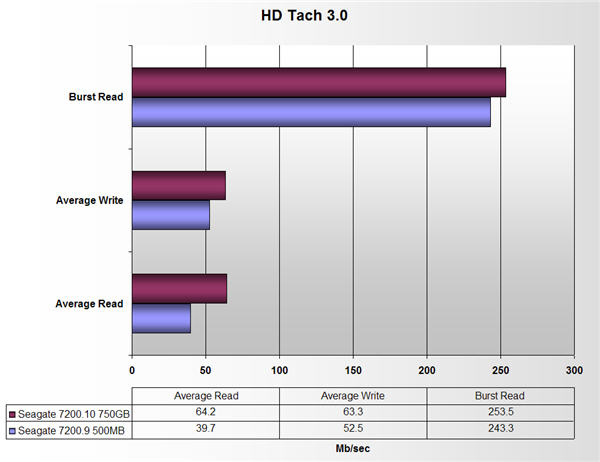
PCMark05 Benchmark

Impression
The included benchmarks indicate it was a very close race between the two competitors, but not to the point of a photo finish! The Seagate 7200.10, 750GB drive does win in almost all categories in most cases the victory is marginal while in a few of the tests it runs away from the competition handily. After reading quite a few hard drive reviews on the Web Scott and I were in complete agreement that next to the Western Digital Raptor 150 the Seagate ST3750640AS 750GB is in all likelihood in second place. Even though it’s about twice the price the Seagate ST3750640AS drive offers five times the storage capacity.
CONCLUSION
Scott and I both feel that Seagate has once again come up with a real winner for the storage market with the introduction of the 7200.10 750GB drive. Although not the fastest drive on the market as we alluded to earlier with our mention of the Western Digital Raptor 150, it’s certainly has the most capacity and is no slouch in the speed arena. Remember the Raptor also only offers first genration SATA 150 Mb/sec capabilities while the 750GB drive offers both SATA 150 Mb/sec and SATA 2 300 Mb/sec technology. As the motherboard technology advances to fully utilize the capabilities of SATA 2, the gap should become even narrower.
Scott also reminded me that he had gotten two of these 7200.10 drives due to his need for massive storage capabilities. He stated that in his advanced testing that two of these drives in a RAID 1 configuration are equal in performance to his previous RAID 5 array comprised of three drives. This in itself sold me on the products “real world” capabilities.
The price of the Seagate Barracuda 7200.10, 750GB drive is hovering around the $500.00 USD mark at present. While we realize this may be quite expensive by many people’s standards we don’t feel it’s the least bit unreasonable for the quality, capacity, and performance this drive offers. Think of it this way, you go out and buy 3 250 GB drives to mimic the storage capacity of the Seagate drive for say $50 to $100 less than the cost of the 7200.10. Yeah, you have save some $$$ but you also a three times greater risk of one of these drives failing. In all likelihood the 250 GB drives will not approach the speed of thi 750 GB drive either.
Is a drive with a terabyte’s capacity right around the corner? Common sense would say “No”! Then again common sense also said “No” when it came to seeing a 750 GB drive let alone a completely new recording technology this soon after we were so taken back by the capacity and strengths of the 7200.9 500 GB drive. Three things we’ve learned not to bet on are horseshoes, hand grenades, and computer technology!
In summation, we highly recommend the Seagate Barracuda 7200.10 750GB drive for anyone wanting high capacity storage with excellent performance! The perpendicular technology, although new, appears to be the wave of the future in increasing not only data storage capacity but also commensurate drive speed. Let us also not forget that Seagate currently offers the longest warranty, of 5 years, available on all of it storage line not just the high end models like some manufacturers do. If you do experience a problem with your storage solution, Seagate has what we feel to also be one of, if not the best support departments of any of the major storage manufacturers. We speak of this from a standpoint of experienced users and not product reviewers.
We would sincerely like to thank the wonderful people at Seagate for supplying this product for our examination. It has been a sincere pleasure to review a product of this obvious quality.
Pros:
+ A massive 750 GB storage capacity
+ Very fast, only supplanted by the Western Digital Raptor 150
+ 16MB cache
+ Considerably better cost/GB ratio than SCSI
+ 5 year warranty
+ 150 Mb/sec and 300 Mb/sec I/O threshold
Cons:
– Price for general use may be prohibitive for some
 Bjorn3D.com Bjorn3d.com – Satisfying Your Daily Tech Cravings Since 1996
Bjorn3D.com Bjorn3d.com – Satisfying Your Daily Tech Cravings Since 1996



